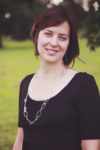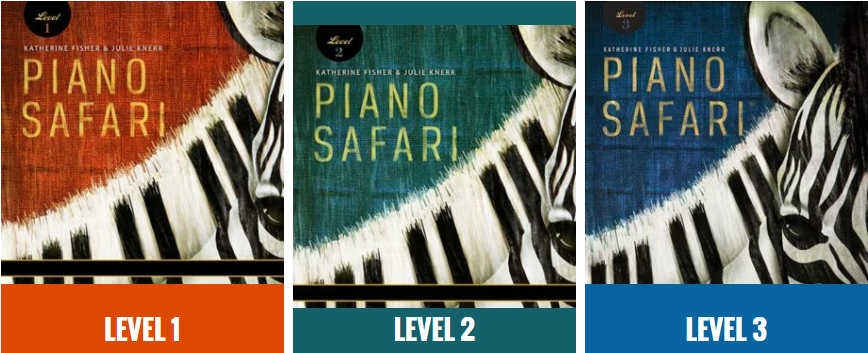Piano Safari Piano Method Books
Piano Safari Conversation with Katherine Fisher and Julie Knerr
Piano Safari Interview: Katherine Fisher and Julie Knerr visit the-piano-studio.com to discuss their collaborative piano method book series called Piano Safari. We talk about how they met, how the series came to light, how best to use this method in your studio, and what’s coming next for Piano Safari.
Meet Katherine Fisher and Julie Knerr
 Katherine Fisher
Katherine Fisher
Katherine Fisher is on the faculty of the Athens Community Music School at Ohio University in Athens, Ohio. She teaches private piano lessons and coordinates the Piano Safari Program (group lessons) for children who are beginners at the instrument.
A native of Ohio, Katherine received her degrees from the University of Oklahoma (MM in Piano Performance and Pedagogy) and the Wheaton College Conservatory of Music (BM in Piano Performance).
 Dr. Julie Knerr
Dr. Julie Knerr
Dr. Julie Knerr teaches piano at her home studio in Windsor, Connecticut. Formerly, Julie taught applied piano, piano pedagogy, and group piano as a faculty member at the University of Missouri, Oklahoma City University, and Ohio University.
Julie holds a PhD in Music Education with an Emphasis in Piano Pedagogy from the University of Oklahoma. Additional degrees include MM degrees in Piano Performance and Piano Pedagogy from the University of Illinois at Urbana-Champaign, where Dr. Knerr studied piano and harpsichord; and a BM in Piano Performance from the University of Puget Sound.

1. With so many method books out there, why did you decide to develop Piano Safari?
Julie Knerr and I met at the University of Oklahoma when we were working on our graduate degrees, and we found we had a mutual dream of writing a piano method for young beginners. This desire was born out of a love for pedagogy and for teaching children. We genuinely enjoyed debating pedagogical topics in the university piano pedagogy library and found it exhilarating to put our ideas down on paper. We wanted to create a product that combined our favorite pedagogical traditions in a new and creative way. We began this process in 2002 and have been working on the method since this time. We began to sell Level 1 in 2011, almost 10 years after we began! This length of time was not for lack of working on the book, but because we were going through a constant process of revision and testing. Level 2 was finished in 2013, and we just released Level 3 in April 2016!
2. What problems with traditional methods did you hope to solve with Piano Safari?
As a result of our examination and use of various piano methods, we have come to believe that the primary goal of some of the early level methods is not necessarily to teach children to play the piano. Instead, the goal of these methods is to teach children to read music notation at the piano. Because of this intense focus on reading, these methods can be compared to a grammar book intended to teach a student an ancient language.
Although a person may learn to read and write in ancient Greek through a grammar book, it will not be useful for learning to speak the language the way it sounded in the time of Alexander the Great. In order to speak the language correctly and become fluent, one would need to hear the language spoken and practice speaking it.
In the same way, a piano method that is focused exclusively on reading music notation may guide the teacher in teaching students to read music notation, but it may not teach them to understand music aurally or to express it artistically.
Also, students may become disillusioned and uninspired when all the pieces in the book are at the same reading level with the same texture of single line melodies and simple rhythms. Most children have been exposed to complicated music since birth, and they are capable of playing more difficult music than they can read.
Teaching students by rote (i.e. by imitation without extensive reference to the score) allows students to develop their ears, technique, and memory without the added complication of reading the notation. Music is an aural art, so students must learn music with their ears as well as with their eyes. A balance between pieces taught by notation (eye) and those taught by rote (ear) will help students deeply understand and fully express music. Piano Safari was designed to achieve this balance. We include patterned pieces that are to be taught by rote alongside an intervallic reading approach.
An additional element we felt needed to be addressed was in the area of technique. Most method books provide little instruction as to how a piece is to be played. Legato? Non legato? With fingers? With arm? These questions drove Dr. Knerr to write her doctoral dissertation on the subject of beginning technique. (You can read the entire dissertation at the Piano Safari website under Teacher Resources–links are at the end of the article). This research led to the seven animal techniques found in Piano Safari Level 1. Each animal represents a technical motion or articulation that students should master at the beginning of study.
3. Are you targeting your books toward a certain age range? Is there anything coming for adults and teens?
Piano Safari was designed for the average age beginner (5-11) but we have found that it also works with students as young as 4. We plan to design a version for older beginners (teens and adults) and also write a book to ease younger preschoolers into Level 1.
Our Sight Reading & Rhythm Cards may be used with any age of student and are great for teens and adults. Some older beginners also enjoy our Rote Pieces. These may be found as individual sheets or in the Technical Exercises & Rote Pieces Book.
4. Your website says you can use this course of study to supplement other methods. How would you recommend incorporating this?
Several of our products may be used to supplement other material. For example, if a teacher desires to teach the Piano Safari Rote Pieces and technical approach, they may purchase the Technical Exercises & Rote Pieces Book, which contains excerpts from Repertoire Book 1 and 2. This book may be used with a student who is learning to read notation from another method.
The Sight Reading & Rhythm Cards use an intervallic reading approach in Levels 1-2 and a multi-key approach in Level 3. Although they correspond directly with our series, they may also be used to supplement another method. Teachers interested in this option may purchase our Sight Reading Card Pack, which contains all three levels of cards.
5. Can you take us through an ideal mini-lesson plan of a teacher using your Piano Safari course?
A 45 minute lesson with a first year student using Piano Safari might include the following activities:
- 10 minutes: Sight Reading & Rhythm Cards. We help the student analyze the intervals for each reading exercise and then play it three times. They tap the rhythm exercise on the piano or the drum.
- 5 minutes: Work on a new technical exercise or review a previous exercise.
- 10 minutes: Work on current pieces to refine them. The pieces in each unit can be assigned in any order to achieve a balance in the assignment between Rote Pieces and Reading Pieces.
- 10 minutes: Introduce one or two new pieces.
- 5 minutes: Review pieces. We enjoy having students keep many pieces in their repertoire so that they eventually can play an entire unit in the book. Keeping review pieces over an extended period allows students to gain confidence and technical fluency. We like to add creative variations to the Review Pieces. For example, the student can play a piece in a different octave, play the drum while the teacher plays the piano, transpose the piece, play it at various tempos or dynamic levels, etc. This creates a musical experience at the lesson for the student.
- 5 minutes: Improvisation or a theory game. We have several Improvisation Pieces included throughout the book.
6. What do you hope that teachers and students will take away from learning your course?
- Master the reading of notation through a systematic intervallic approach that allows for extended practice with each interval before adding other intervals.
- Gain a solid technical foundation that will allow students to progress to higher and higher levels of pianism.
- Develop motivation and love for music though fun and colorful Rote Pieces
When we started teaching students using Piano Safari, we found that along with the three areas above, students also gain a fearlessness at the piano, confidence, and the ability to express their creativity in composition and improvisation.
7. What’s coming next for Piano Safari?
- Exploring options for making our materials more easily available to the international market. Shipping from the U.S. is expensive, so we are working to make more of our materials available digitally.
- Teen/Adult beginning method
- Preschool primer
Finally, we will continue to write pedagogical resources that will support all piano teachers. We are pedagogues at heart, and we love to write materials that aid teachers in their work.
Links
Want to read more about Katherine Fisher and Julie Knerr’s Piano Safari books, or looking to purchase these method books? Visit their website at www.pianosafari.com.
Return to top of this page.
Return to home page of the-piano-studio.com.